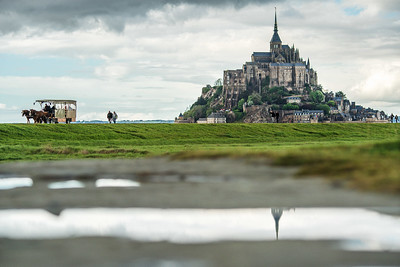
Lifestyle, sights, natural spectacles – Normandy is something like the Provence of the North. World-famous French specialities such as camembert and cider have their origins in the landscapes of Normandy, landscapes that have fascinated artists of all times, above all Claude Monet.
The region on the English Channel looks back on a long, eventful history, a history of which many testimonies from past centuries can still be seen and experienced throughout Normandy today.
Normandy’s nature also offers special experiences. River landscapes, forests and of course the many beaches make Normandy one of the most interesting regions in France.
Discover now:
Départments & Regions
Calvados
Calvados is Normandy par excellence. Endless sandy beaches like in Hermanville, picturesque harbour towns like Honfleur, seaside resorts like Deauville and typical specialities like cider and the eponymous apple brandy Calvados – clichés in all their glory can be experienced and enjoyed in abundance in the département of Calvados.
Beneath this surface, there is another Calvados. With pastures and hedgerow landscapes stretching left and right along the winding country roads. With the “Alps of Normandy”, the unexpected Suisse Normande, offering relief and breathtaking views into the distance. With the Orne estuary, home to seals and numerous bird species.
Or the Pays d’Auge, with its so charming typical half-timbered houses.
Eure
The Eure department stretches from the border with Île-de-France in the southeast to Honfleur in the northwest. It does not have a seashore and cannot compensate for this lack in comparison to other parts of Normandy with numerous spectacular sights. The most remarkable tourist attraction is Château Gaillard near Les Andelys. However, the small towns of Vernon (the “Vieux Moulin” in the town served Claude Monet as a motif several times), Le Neubourg (impressive castle Le Champ de Bataille), Beaumesnil (baroque-style castle) or Évreux (with parks worth seeing and Notre-Dame Cathedral) are also well worth a detour.
In addition to the quiet towns of the Eure, which have retained their charm like those listed above, it is rather the landscapes with their large forests, lush pastures and the valley of the Seine that make up the charm of the département.
Manche
The Manche department has the longest coastline in the Normandy region. From the flat Baie du Mont-Saint-Michel in the far west to the west coast of the Cotentin peninsula with Cap Cotentin in the north to the mouth of the Vire in the east, diverse landscapes extend directly along the coast of the English Channel that gives the department its name, “La Manche”. Mudflats, marshland and cliffs alternate and offer animals the most diverse habitats and visitors fantastic perspectives of the sea, which can be enjoyed completely undisturbed in many places.
Holidaymakers can experience nature at its purest on the beaches of Barneville-Carteret, the Anse de Vauville or around Barfleur, for example. By the way, picturesque Barfleur is one of the 6 villages in Normandy that can officially count themselves among the “Most Beautiful Villages in France”.
But the department is also home to the extreme opposite of lonely, dreamy villages and bays. With Mont Saint-Michel, the most visited sight in France outside Paris is located in the region.
Orne
The colours red, blue and gold can be found in the coat of arms of the Orne département. Green and white would be much more appropriate to describe Orne. Away from the English Channel, forests alternate with pastures that thrive in the lush green of Normandy’s mild, humid climate. In the quiet forest of Andaines, on the border with Brittany and the Mayenne département, lies Bagnoles-de-l’Orne, blessed with thermal springs, a spa town entirely in the style of Belle Époque and Art Deco. In the Perche Nature Park, also in western Normandy, another impressive forest area awaits, the Bellême forest. Further east, the green Suisse Normande mountains can be admired and climbed.
White stands for the traditional lace from Alençon, the worth seeing capital of the Départment Orne. White are also the “Percheron”, horses from the Haras du Pin horse breeding farm, which can proudly call itself the national stud farm. And Orne is also home to the most famous culinary speciality in the whole of Normandy: the white cheese Camembert.
Seine-Maritime
Le Treport to the east, Le Havre to the west and Rouen to the south form the triangle in which the area of the Seine-Maritime department lies. The region to the right of the Seine estuary is home to many spectacular sights. Attractions of time-honoured Rouen with its imposing historical buildings and museums and, in contrast, Le Havre with its beach life and its modern and no less impressive architecture can be found in every travel guide about Normandy. Holidaymakers with a sense of history and culture are also drawn to highlights such as the Forges-lex-Eaux thermal spa in the interior of Seine-Maritime, the picturesque and historic town of Eu, the market of Dieppe or the Palais Bénédictine in Fécamp.
The natural beauty of Seine-Maritime is on a par with its culture and architecture. From unusual coastal formations such as the cliffs of Étretat, to the forest landscapes in the south and east of the department, to the river landscapes of the Parc Naturel Boucles de la Seine Normande, nature shows itself at its best here in the north of France.
Most Beautiful Beaches
The Normandy coast offers more than 600 kilometres of beaches, making it a place of longing for all those who love the sea. The coast on the English Channel is varied and diverse: the most beautiful beaches in Normandy include natural tidal landscapes as well as bays in the middle of the cliffs, lively city beaches, the wide beaches of the fashionable seaside resorts and the historic landing beaches.
The 5 most beautiful beaches include:
- Étretat for its exceptional panorama defined by huge arching chalk cliffs below the cliff.
- The double beach of the municipalities of Deauville and Trouville because of the palpable flair of bygone (glamorous) times and the still fashionable character today.
- Barneville-Carteret, one of the most beautiful beaches on the Cotentin peninsula, from which beach-goers have a magnificent view of the Channel Islands.
- Anse de Vauville, a natural stretch of coastline and ideal retreat for lovers of authentic landscapes.
- Hermanville, one of Normandy’s typical, seemingly endless sandy beaches, ideal for long walks and, in beach weather, for swimming.
Weather And Best Time To Visit
The weather in Normandy is distinctly maritime. In plain language, this means comparatively much rain and no great differences in temperature between the months. As a holiday region, Normandy tends to attract guests who do not want to spend their holidays under a blazing sun, even during the summer peak season.
In the months from June to August, average temperatures range between 15.5°C and 18°C – whether measured at a seaside resort or in the interior of Normandy. Even though Normandy has not been completely spared the summer heatwaves of recent years, major swings up or down during the holiday season tend to be the exception.
Almost parallel to the outside temperatures, the average water temperatures in the seaside resorts remain at the level of 14°C and 18°C in summer.
In the low season, the months between November and February are particularly uncomfortable, with lots of wind and rain. September/October and spring have better conditions, although they can be unstable.
History Of Normandy
Until the 20th century, the history of Normandy was marked by armed conflicts. In ancient times, the Romans took possession of what is now Normandy by force. After campaigns against the local Gauls, the last resistance to Julius Caesar’s armies was broken in 51 BC. The area then belonged to the Roman Empire for more than 4 centuries. Today, however, this epoch can only be traced in a few testimonies, such as the open-air theatre “Théâtre Gallo-Romain” in Lillebonne.
The actual beginnings of Normandy’s history as a largely independent cultural and political region are closely linked to its namesakes – the Normans. The first documented Viking attack in 799 was during the reign of Charlemagne, and in the following decades the conquerors regularly plundered and pillaged settlements, especially along the Seine. From the middle of the 9th century, the Norsemen wintered in what is now France, but more peaceful times did not dawn until the Normans settled down: in 911, Norman Prince Rollo was given territories between the English Channel and Paris as an official fiefdom to prevent further uncontrolled attacks by Scandinavian warriors.
The descendants of the Normans not only held their own, they even succeeded in expanding their sphere of influence. William the Conqueror crossed the English Channel and became King of England. With interruptions, the dukes of Normandy were also kings of England for almost 100 years. Normandy remains under the rule of the descendants of the Norman princes until 1204, in which year the French King Philip II conquers the duchy and annexes it to France.
From 1337, the Hundred Years’ War was fought on the territory of Normandy. During this time, various conflicts between the English and the French for supremacy on the coasts of the English Channel and rival French noble houses for the crown of France intermingle. Joan of Arc becomes the symbol of the Hundred Years’ War. The national heroine, declared a saint by posterity, symbolises the harshness and fervour with which the conflicts were fought out. Despite the bloodshed, historians rate the era as an important milestone in the formation of the French state.
In the 20th century, Normandy was once again the scene of armed conflict. In the summer of 1944, tens of thousands of soldiers lost their lives when Allied troops invaded northern France, which was occupied by the Wehrmacht. Today, monuments and cemeteries on the beaches of the Channel coast and in the Normandy hinterland commemorate this bloody chapter in Normandy’s history.
